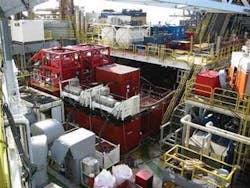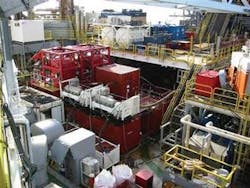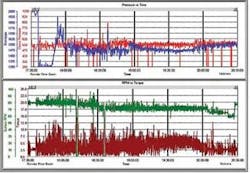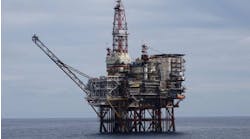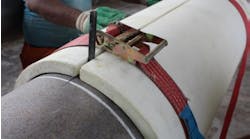Fred Curtis, Randy Lovorn, Jeremy Greenwood • Sperry Drilling Services
Managed pressure drilling (MPD) uses controlled formation pressure during drilling operations to reduce non-productive time to increase return-on-investment. IADC defines managed pressure drilling as “an adaptive drilling process used to precisely control the annular profile throughout the wellbore. The objectives are to ascertain the downhole pressure environment limits and to manage the annular pressure profile accordingly.”
While this technology is a step-change from conventional wisdom, it is not a quantum leap. However, the technology has proven itself to be a better and safer way to drill in several environments.
The process
MPD is drilling with a controlled annulus pressure using an equivalent mud weight maintained at, or marginally above, formation pressure using a dedicated choke device or other method. The intention is to keep reservoir fluid from reaching the surface.
The primary purpose of MPD is to enhance well construction by minimizing drilling problems, with reservoir benefits a secondary advantage. As a drilling solution, MPD can improve ROP and extend bit life, as well as minimize differential sticking and lost circulation. Able to drill narrow pressure margins efficiently and safely, MPD can reduce the number of casing strings required and allow integration of MWD/LWD, directional, engineering, and mudlogging services.
Where very narrow or inverse pore pressure/fracture gradients or fractures/permeable zones increase the potential for fluid influx, an MPD set-up may include downstream fluid separation equipment to safely process fluid within the pressurized system. Best practices will drive system design and dictate surface equipment required based on specific project objectives, as well as reservoir conditions.
Optimizing MPD
Depleted reservoirs or hole sections with narrow pressure margins historically have been insurmountable barriers to new reserves. A team of in-house MPD experts plus a competent service provider is the most efficient method to plan MPD. Initially, the most important considerations to determine what the operational pressure window should be in relation to either the pore pressure, collapse or the fracture pressure of the formation; and to maintain bottomhole pressure within the mud window for a proposed section.
GeoBalance MPD
Given the different levels of reservoir complexity faced today, a Halliburton GeoBalance MPD service team was assembled to assist operators.
The team provides a suite of pressure optimization solutions to increase drilling efficiency and safety while navigating complex pressure regimes and unstable formations. The techniques and equipment have been designed to control bottomhole pressure throughout the entire pressure range – from underbalanced, to at-balance, to over-balanced drilling – and to maintain precise pressure control through narrow margins.
The initial decisions on design complexity can only be made once the specific challenges and the problems that need to be solved are identified.
The first and most important consideration is what the bottomhole pressure should be in relation to either the pore, collapse, or fracture pressure of the formation, and how wide the mud window is for a proposed section. This should be done so the optimal service level can be determined up front and the required pre-well modeling can take place.
Four service levels have been developed to address different difficulties of pressure control: self managed level, an automated level, an optimized level and the Sigma level.
Self managed level
The simplest level is a rotating control device (RCD) with a manual choke. An operator can manage the equipment after training the rig crew to monitor well conditions and to maintain the equipment.
A typical operation suitable for the self-managed service would be kick control. For example, in an area with severe lost circulation potential, the operator may choose to rig up the self-managed service as a contingency in case of losses followed by a kick. Another area where this level may be applicable is regions where high rock strengths and low permeability result in low rate of penetration (ROP). A reduction of the confining stress or drilling fluid weight applied to these formations can result in linear to exponential ROP increase, depending on the mode of operation.
Full-time supervision of the equipment is not necessary because there normally would not be pressure under the RCD, but the annulus is continually closed for increased safety. With the annulus controlled by the RCD, the rig floor will not be exposed to any flow or hazardous gases while the BOP stack is being activated. Conventional well control methods would be used to circulate out a kick.
Automated level
The second level adds automated control software, choke manifold, and metering capability to measure flow rates and also surface pressures to manage the choke manifold pressure. This system can maintain the bottomhole pressures within a very small window. Software tabulates the various data to compute the actual choke set point and operates the choke manifold automatically to maintain the correct set point. The software accomplishes this through communication with the choke’s programmable logic controller (PLC). The PLC is a mechanical device that adjusts the choke to the desired position or pressure. Communication between the two is either through OPC protocol (OLE for Process Control) or by conventional network protocol.
When pore pressure and fracture pressure are close together, there is little room for error. In this scenario with conventional drilling operations, a situation known as “wellbore ballooning” or “wellbore breathing” can develop. This happens when the hydrostatic pressure created by the static mud weight is below the fracture opening pressure. The increase in bottomhole pressure generated by frictional pressure losses when circulating is above the fracture opening pressure. During circulation fractures are opened and charged with drilling fluid, during periods of no circulation the fractures close and the drilling fluid is returned to the wellbore resulting in a cycle of losses and gains and damage to the wellbore.
The bottomhole pressure can be expressed as the following formula:
BHP = HP + FP + AP
Where:
BHP = bottomhole pressure
HP = hydrostatic pressure
FP = friction pressure (ECD)
AP = applied pressure (choke).
In conventional drilling, adjusting the hydrostatic pressure by lowering the mud weight to avoid ballooning requires both time and expense, and may not be possible if it has to remain above the lower pressure limit. Reducing the mud weight also can impact wellbore stability if argillaceous sequences higher in the wellbore have been exposed to the higher mud weights. The frictional pressure losses can vary significantly and are controlled by the depth of the hole, mud properties and the size of the annular clearance between the drillstring and the wellbore. The frictional pressure loss can be controlled by reducing the flow rate, though this may cause inefficient hole cleaning and lead to other drilling problems. The frictional pressure losses also may be controlled by altering the rheology. This, too, is both time consuming and expensive, and reduces the cleaning efficiency of the mud.
The most easily controlled variable in this system is the applied pressure from the choke. During normal operations, the static mud weight must remain above the pore pressure to avoid an influx and remain above the collapse pressure to avoid wellbore failure. The GeoBalance automated service allows the static mud weight to be at or lower than these limits. This correspondingly reduces the total pressure exerted on the formation from the frictional pressure losses when circulating and allows the annular pressure to remain below the fracture opening pressure preventing the occurrence of “wellbore ballooning”. To prevent an influx or wellbore failure, a back pressure or applied pressure is maintained on the annulus using the choke during periods without circulation. This ensures the wellbore pressure is maintained above the lower limits.
Optimized level
Combining the automated level with the ADT Optimization level enables the operator to increase the accuracy of bottomhole pressure control and to maximize drilling efficiency.
Combining these levels maximizes drilling time and minimizes non-productive time. This is achieved by experienced engineers using a suite of software applications, plus surface and downhole measurements to model, measure, and optimize. Pre-drill models are generated to determine the expected conditions. These pre-drill models are verified and updated during drilling with the actual measurements. Any differences are analyzed and acted upon if a potential problem is identified. The drilling process is then optimized based on the actual drilling conditions encountered with recommendations to improve drilling performance or eliminate the drilling problems.
To focus on different aspects of the drilling process, the ADT level contains three disciplines.
First is a drillstring integrity discipline which focuses on eliminating excessive forces on the drilling assembly, modeling the natural frequencies of the drilling assembly to avoid resonant conditions, measuring shock and vibrations, identifying any active vibration mechanism, and supplying the right corrective actions to eliminate drilling vibration.
Second is hydraulics management which focuses on managing the wellbore pressures using accurate pre-drill and real-time hydraulics models plus surface and downhole pressure measurements. It also addresses hole cleaning efficiency using predictive software, analysis of annular pressures from downhole tools, and by comparing predicted torque and drag to those encountered.
Third is wellbore integrity which focuses on determining the wellbore pressure boundaries, the upper limit, which is the fracture pressure, and the lower limit, which is either the pore pressure or wellbore collapse pressure. Accurate pore pressure prediction which hinges on knowing which of the 20 pore pressure generation mechanisms are active in the area and knowledge of the rock mechanical properties are essential in determining these limits.
Sigma level
Many drilling problems are incurred because the formation pressure has been lowered through production. Formation pressure can be so low that any liquid phase drilling fluid is too dense to allow the targeted bottomhole pressure to be reached. In these cases, a two-phase fluid, foam, mist, or gas may be used to lower fluid density. The addition of a gaseous medium requires the addition of an upstream injection system and a downstream separation system.
This rig-up looks like an underbalanced rig-up and the techniques used will be the same. The only difference is in the relationship of the targeted bottomhole pressure to the formation pressure and a lack of production to the surface.
The question becomes whether to drill underbalanced or use GeoBalance. The correct bottomhole pressure to formation pressure relationship is determined by the drilling or production problems encountered.
Acknowledgements
The authors thank Halliburton Energy Services for permission to publish the technical data contained in this paper.
